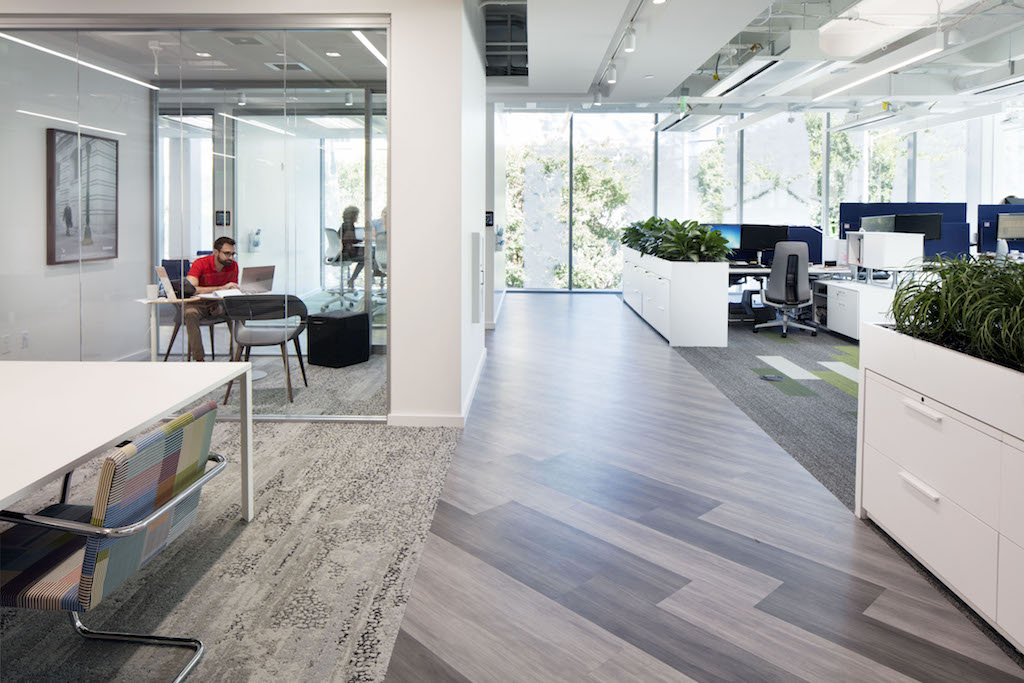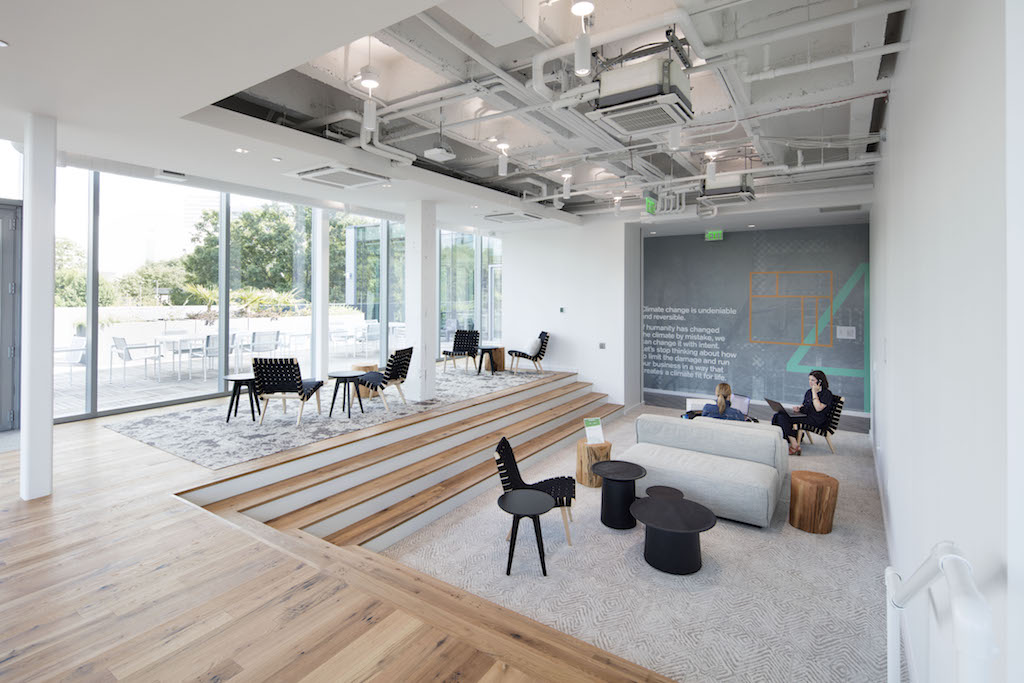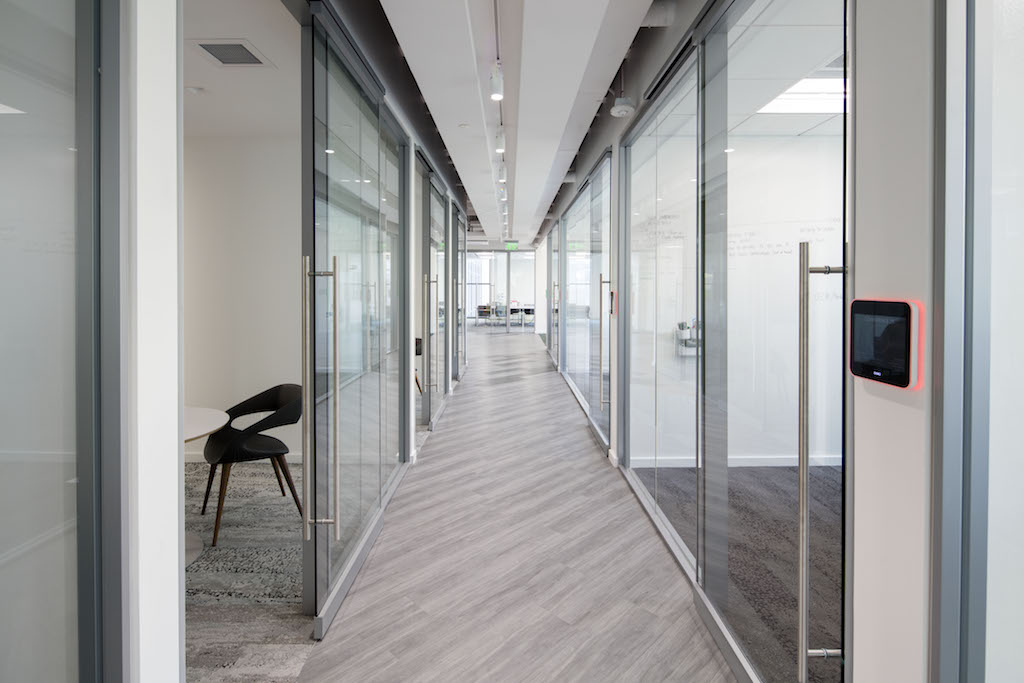Interface’s Chip DeGrace explains why companies need to design spaces that are representative of the diverse job functions that reside in a given workplace in order to recruit and retain top talent.
The current unemployment rate is at 3.6 percent, a record low since December 1969. With an abundance of opportunities available across the job market, a shift has occurred, placing job candidates in the power position of selecting their employer. To attract top talent, company purpose and culture remain key drivers in the job market, but must be articulated in the physical space as well.
Candidates are becoming increasingly savvy to the design elements and their benefits, or drawbacks, with the physical workspace. If a company’s mission statement includes wellness commitments but does not allow for natural light in the workplace, job candidates will take note. With this in mind, companies are urged to move beyond cultures centered around cold brew on tap, and instead design spaces and provide resources that are representative of the diverse job functions that reside and thrive in a given workplace. If a prospective job candidate asked your current employee about their work environment, would they respond positively? Creating a workplace that fosters innovation and creates a healthy environment for employees is crucial for attracting the best in the business.
Designing for Collaboration and Productivity
Today’s workforce expects companies to provide more than a cookie-cutter workspace and experience. The workplace should be as diverse as those that inhabit it, providing spaces and elements that fit the needs of the individual and their work habits. To bring in top talent for every position, employers need to consider that candidates at all levels want to spend time in a place that supports their needs throughout the entirety of their day. Each workday brings different responsibilities that require varied work strategies and different spaces to support them, including open collaboration spaces and quiet rooms, all dependent on the size of the team, the objectives, and individual preferences.
According to Sasaki, the workforce can often be divided into three workplace archetypes depending on collective needs and behaviors: Soloist-Style, Mixed-Style and Mobile Mixed-Style. The Soloist-Style employee prefers to spend the majority of their time at their desk; the Mixed-Style employee is in the office, but often not at their desk; and lastly, the Mobile Mixed-Style is found traveling for the majority of their week and doesn’t require a permanent workstation. While these three workstyles are not applicable to all companies, or even industries, it’s clear that workspaces must be outfitted to provide space for all types of employee to ensure productivity, happiness and wellness.
Designing for Every Employee
Today’s workforce tends to divide across generational bounds in terms of needs and expectations, but to attract top talent, a space is required that encompasses different work stations for all need. Individuals from each of the four generations that comprise today’s workforce – baby boomers, Gen X, millennials, and the most recent college graduates, Gen Z – have different needs surrounding their physical workspace. Senior-level executives and entry-level associates may work best in a semi-private space that allows for immersive focus and minimal distractions, while others may feel more inclined to expand their creativity by working near others, encouraging the sharing of ideas and thoughts.
While focus is often placed on millennial’s and Gen Z’s needs for purpose-driven employers, research has found that these generations also search for workplaces that promote overall wellness, both physical and mental. According to a recent study, over 80 percent of the millennial and Gen Z workforce believes that employers should have better mental health programs. While the youngest generations expect support for psychological and physical well-being, employers should consider employee well-being at all ages and career levels. Have a headache? Find a wellness space. Stuck on a problem? Go find a coworker. Falling asleep at the wheel? Get close to nature.
Balancing Privacy, Visibility and Connection
Beginning in the 1970s, “cubicle farms” were the default workplace design model for most offices. However, employers and employees alike became disillusioned with these isolated workspaces as the negative impacts on workforces became more apparent. For example, cubicles fail to offer employees access to a view of nature outside of the office. Natural light and greenery support our human connection to the natural world.
College campuses, home to a majority of the millennial and Gen Z workforce prior to their current workplaces, offer extensive access to nature, from walking across campus between classes to large windows in classrooms and common spaces, representing the need for stimuli across these generations. If the work environment is void of nature, employees can experience adverse effects on their health, productivity and well-being. Cubicles do not support this innate human connection to nature known as biophilia.
Open office design began as a response to combat the negative repercussions associated with cubicle-heavy office design. However, issues with open office floorplans have also been widely documented. While cubicles may have limited the possibility of face-to-face interactions between employees, privacy quickly becomes hard to find in open offices unless properly addressed. Without proper allocation of private and public space, open concept office layouts can result in poor acoustics and a lack of privacy. A recent global study found that more than half of offices are described as “noisy,” and 69 percent of office workers in disruptive spaces state noise negatively impacts their concentration levels, productivity and creativity. In addition, studies have found that employees in open offices revert to email correspondence between 22 and 50 percent more often due to limited privacy and a fear of being overheard.
Designing for Flexibility
Instead of operating at two extremes of privacy or visibility, companies are shifting toward a new workplace methodology, which creates spaces for all employees and every task: work choice. With work choice, or free address, employees select the workspace that best fits their needs throughout a given day. Workplaces that operate with free address in mind allow employees to shift their space, no longer requiring static workstations and recognizing that employees have differing needs for projects and tasks depending on the time of day, collaboration and creativity needs and more.
The top talent across all industries desire to feel supported and encouraged by their employers. This support extends into outfitting a space that fosters the individualized experience and promotes productivity and wellness. To encourage innovative thinking among employees, employers should outfit their built spaces to move and change in response to the needs of their innovative employees.
Designing with Intention
According to executive coach and Innovators + Influencers founder Michael O. Cooper, companies can begin their journey toward fostering a workforce that excels at creativity and cognitive diversity through 12 steps. Of these 12 steps, a few stand out in relation to the importance of work choice: Create psychological safety, give people autonomy, nurture cooperation, reduce or eliminate bureaucracy, and provide sufficient resources and time. These principals can be achieved through creating a workplace that enables free address, supporting employee wellness and free will in deciding how to work, encouraging collaboration, and minimizing the need for private offices for executives, allowing for conversation across levels.
Employers can successfully partake in this trend by designing the space with intention. For example, workplaces can implement wayfinding into the design of the space. Wayfinding allows visitors and employees to experience the area organically while encouraging collaboration or casual collisions, as well as signifying solo-work and activity zones. By using design cues in the flooring, the open office space can support work choice and free address.
In addition, to combat the acoustic dangers of open offices, while still benefiting from work choice, specifiers should consider material choice. Although recent trends lean toward sleek and modern hard surface materials, such as concrete, it is essential to select products with acoustic benefits, specifically for floors, ceilings and walls. Similarly, designing to the WELL Building Standard (WELL) ensures acoustic, air, water, nourishment and comfort elements combine into one human-centered design philosophy.
Placing existing and prospective employees at the center throughout the workplace design lifecycle improves productivity, creativity and wellness. Promoting these advantages and considerations to potential employees is crucial in securing top talent across the workforce. By investing in a healthy environment for employees, companies make a long-term commitment to their staff to provide positive spaces, allowing for longer and healthier relationships between companies and their employees.







[…] Read more on workdesign.com/2019/06/workpl…. […]